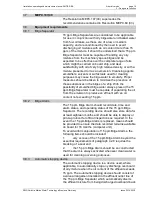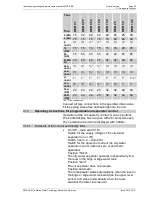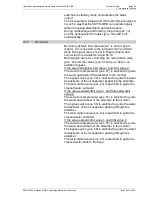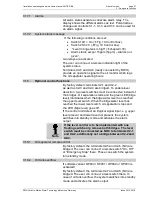
Installation, operating and maintenance manual SKIT/S-DEB
3rd print version
page 17
3 – Design and function
RWO GmbH
●
Marine Water Technology
●
Bremen
●
Germany
Issue 2014-04-10
The entire oil separator system (as of type SKIT S-DEB
0,25) is screwed to a base (pos. 16) which can be welded
in the engine room of the ship.
The second stage is equipped with adsorber cartridges.
The pump (pos. 14) (as of type SKIT S-DEB 0,25) is
attached to the container, connected by tubes and cables.
All piston valves (fig. 4, pos. 4, 5, 15, 23, 58) are
controlled by a valve terminal with the tube connections
ready upon delivery.
The automatic control box (pos. 3) is connected to the
system and wired to the sensor electrode, the electric
heater, the pump and the oil monitor OMD.
The oil monitor OMD is attached to the oily water
separator. The sample water lines and the electric system
are ready installed.
The plant (as of type SKIT S-DEB 0,25) is equipped with
an electric heater (pos. 10) in the upper part of the oil
separator which keeps the separated oil in a liquid state. A
thermo element limits the temperature; by defaults it is set
to 40
°
C. It is controlled by a contactor in the automatic
system control box (pos. 3). The heater can also be
switched off manually using a switch
à
Fig. 10 Control
box.
The first stage is equipped with a drain valve (pos. 27) and
a pressure reducer valve (pos. 36).
Optionally, the oil separator system can be equipped with
a steam or thermal heater instead of the electric heater
and with a temperature control valve.
The oil separator systems are coated with a two-
components epoxy resin on the inside.
The outer coating consists of a universal primer and a
machine varnish.
(Any differing scope of delivery can be found in writing in
our order confirmation.)
3.3
General function and proper use
The IMO Resolution MEPC.107 (49) has been brought
into force on July 18th, 2004, and refers to all bilge water
oil separators and 15ppm alarm systems installed aboard
ships after January 1st, 2005.
IMO Resolution MEPC.107 (49) describes the details of
the type test for oil separators and 15ppm oil content
alarm systems. The main different to the old Resolution
MEPC.60 (33) consists in that the new MEPC.107 (49)
includes an oil in water emulsion. This emulsion is
generated by mixing the different test oils with a specified
emulsifying chemical and an iron oxide powder for an hour
under controlled conditions using a centrifugal pump with
high speed. The bilge water oil separator must be able to
split the emulsion and to separated oil residues.
An emulsion is a mixture of two or more components. In
this case it includes oil and water. This mixture contains
















































